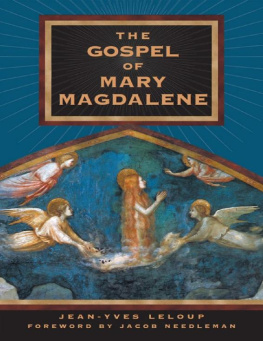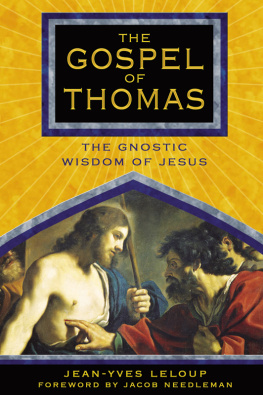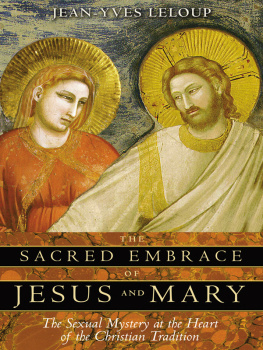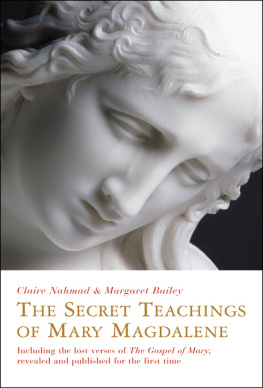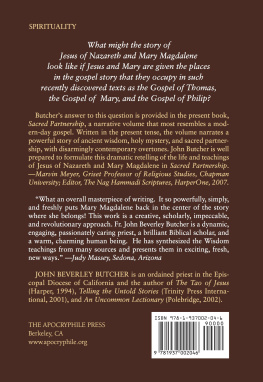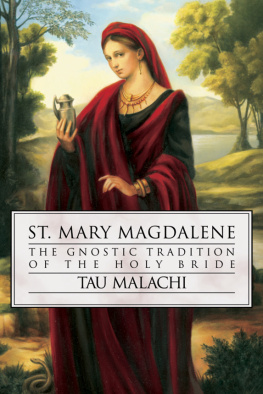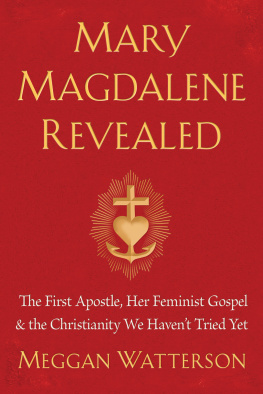Jean-Yves Leloup - The Gospel of Mary Magdalene
Here you can read online Jean-Yves Leloup - The Gospel of Mary Magdalene full text of the book (entire story) in english for free. Download pdf and epub, get meaning, cover and reviews about this ebook. year: 2014, publisher: Inner Traditions/Bear & Company, genre: Religion. Description of the work, (preface) as well as reviews are available. Best literature library LitArk.com created for fans of good reading and offers a wide selection of genres:
Romance novel
Science fiction
Adventure
Detective
Science
History
Home and family
Prose
Art
Politics
Computer
Non-fiction
Religion
Business
Children
Humor
Choose a favorite category and find really read worthwhile books. Enjoy immersion in the world of imagination, feel the emotions of the characters or learn something new for yourself, make an fascinating discovery.
- Book:The Gospel of Mary Magdalene
- Author:
- Publisher:Inner Traditions/Bear & Company
- Genre:
- Year:2014
- Rating:4 / 5
- Favourites:Add to favourites
- Your mark:
- 80
- 1
- 2
- 3
- 4
- 5
The Gospel of Mary Magdalene: summary, description and annotation
We offer to read an annotation, description, summary or preface (depends on what the author of the book "The Gospel of Mary Magdalene" wrote himself). If you haven't found the necessary information about the book — write in the comments, we will try to find it.
The Gospel of Mary Magdalene — read online for free the complete book (whole text) full work
Below is the text of the book, divided by pages. System saving the place of the last page read, allows you to conveniently read the book "The Gospel of Mary Magdalene" online for free, without having to search again every time where you left off. Put a bookmark, and you can go to the page where you finished reading at any time.
Font size:
Interval:
Bookmark:

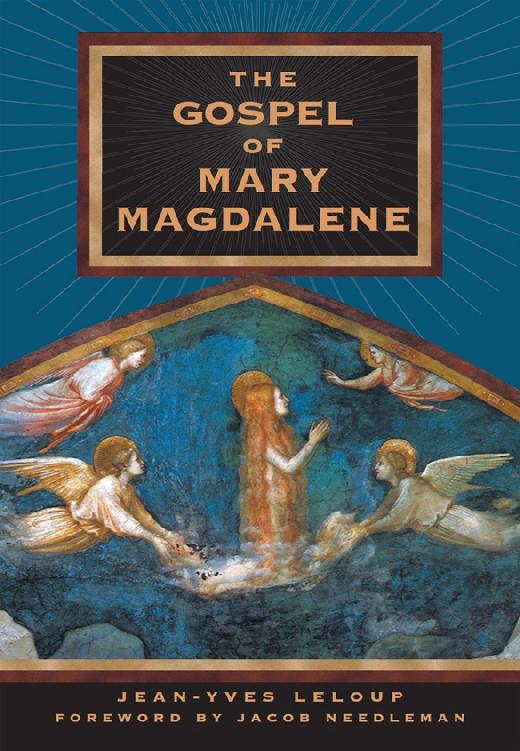
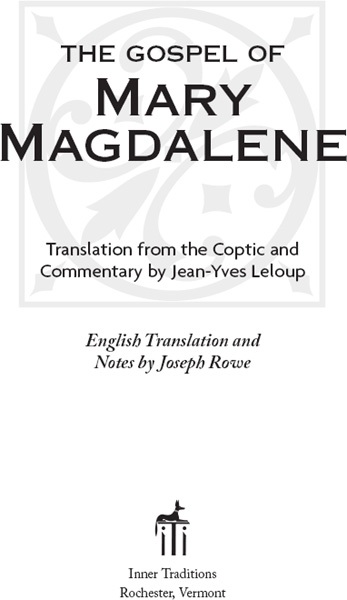 CONTENTSLISTOFABBREVIATIONS NT NewTestament OT OldTestament 1Cor FirstCorinthians(NT) 1Jn FirstLetterofJohn(NT) 1Sm ISamuel(OT) 1Thes FirstThessalonians(NT) 2Jn SecondLetterofJohn(NT) Acts ActsoftheApostles(NT) Col Colossians(NT) Dt Deuteronomy(OT) Eph Ephesians(NT) Ex Exodus(OT) Gal Galatians(NT) Is Isaiah(OT) Jn TheGospelofJohn(NT) Jgs Judges(OT) Lk TheGospelofLuke(NT) Mk TheGospelofMark(NT) Mt TheGospelofMatthew(NT) Nm Numbers(OT) Prv Proverbs(OT) Phil Philippians(NT) Rv Revelation(NT) Rom Romans(NT) Wisdom WisdomofSolomon(OTApocrypha) FOREWORD TheGospelofMaryfirstcametolightinCairoin1896,somefiftyyearsbefore the revolutionary discovery in Nag Hammadi, Egypt, of what have come to be known as the Gnostic gospels, the most well-known of which is the Gospel of Thomas.Likethem,theGospelofMaryoffersthemodernmanorwomananew perceptionoftheimmensityofChristianityandthefigureofJesus. ItisclearthatinbothrootandessencetheteachingofJesusisavisionanda waythathasbeengiventomankindfromasourcefaraboveourknownqualities ofmindandsensibility.Theluminosityandmysteryofwhathesaidanddidtwo thousand years ago is a shock from above that changed the world and that continuestoreverberateinthehopesofmillionsoverthewholefaceoftheearth. But the inner and outer conditions of modern life are such that it has become nearly impossible for many of us to hear the spiritual traditions of the world. TheGospelofMary,takenwiththeinspiredcommentarybyJean-YvesLeloup, can help toward making the teaching of Jesus once again alivethat is, unknown, notinthenegativesense,butinthegreatandfertilemeaningofthat word. Every spiritual teaching sounds a call from above. But, as the present text announces and demonstrates, the central aim of the teaching of Jesus is to sensitize us to the above that also calls to us from within ourselves.
CONTENTSLISTOFABBREVIATIONS NT NewTestament OT OldTestament 1Cor FirstCorinthians(NT) 1Jn FirstLetterofJohn(NT) 1Sm ISamuel(OT) 1Thes FirstThessalonians(NT) 2Jn SecondLetterofJohn(NT) Acts ActsoftheApostles(NT) Col Colossians(NT) Dt Deuteronomy(OT) Eph Ephesians(NT) Ex Exodus(OT) Gal Galatians(NT) Is Isaiah(OT) Jn TheGospelofJohn(NT) Jgs Judges(OT) Lk TheGospelofLuke(NT) Mk TheGospelofMark(NT) Mt TheGospelofMatthew(NT) Nm Numbers(OT) Prv Proverbs(OT) Phil Philippians(NT) Rv Revelation(NT) Rom Romans(NT) Wisdom WisdomofSolomon(OTApocrypha) FOREWORD TheGospelofMaryfirstcametolightinCairoin1896,somefiftyyearsbefore the revolutionary discovery in Nag Hammadi, Egypt, of what have come to be known as the Gnostic gospels, the most well-known of which is the Gospel of Thomas.Likethem,theGospelofMaryoffersthemodernmanorwomananew perceptionoftheimmensityofChristianityandthefigureofJesus. ItisclearthatinbothrootandessencetheteachingofJesusisavisionanda waythathasbeengiventomankindfromasourcefaraboveourknownqualities ofmindandsensibility.Theluminosityandmysteryofwhathesaidanddidtwo thousand years ago is a shock from above that changed the world and that continuestoreverberateinthehopesofmillionsoverthewholefaceoftheearth. But the inner and outer conditions of modern life are such that it has become nearly impossible for many of us to hear the spiritual traditions of the world. TheGospelofMary,takenwiththeinspiredcommentarybyJean-YvesLeloup, can help toward making the teaching of Jesus once again alivethat is, unknown, notinthenegativesense,butinthegreatandfertilemeaningofthat word. Every spiritual teaching sounds a call from above. But, as the present text announces and demonstrates, the central aim of the teaching of Jesus is to sensitize us to the above that also calls to us from within ourselves.
The immensity of Christianity takes its interior meaning as a sign of an immensity withintheselfofeveryhumanbeing.Asapathofinnerawakening,asapathof deep self-knowledge (that is to say, gnosis), it invites and supports the inner struggletoattend,tohearandobeyonesownSelf,Godinoneself.AsJean-Yves Leloup suggests, this is the intimate meaning of Anthropos: to be fullyhumanoneself,theincarnationofGod.Thisisanunknownteachingnotinthe philosophical or theological sense, nor in the sense that it has never been said before,butinthesensethatourordinarythoughtsandfeelingscanneverreally penetrateit.Anditisunknowninthesensethatweliveourlivesonthesurface ofourselves,notknowingtheonethingaboutourownbeingthatitisnecessary forustoknowandthatwouldbringuseverygoodwecouldseriouslywishfor. We are speaking of an unknown part of ourselves, which is at the same time theessentialpartofourselves:theTeacherwithin,ourgenuineidentity.The way and it is surely the way that is offered by all the spiritual traditions of the worldisthepractice,andthecommunitysupportingthepractice,thatopensa relationship between our everyday sense of self and the Self, or Spirit. This interior relationship between self and Spirit, we are told, is made possible through the inner cultivation of a specific quality of conscious attention and intelligencethatinthistraditionisreferredtobytheGreekterm nous, orhigher mind.Itistherealmofintermediateattentionandofmediatingconsciousforces in the cosmos that are mythologized as the angelic realms in the esoteric traditions of the worlds religions. It is in this miraculous yet lawful mediating contact between the higher and the lower within ourselves that the deeper, intimateexperienceofconsciousloveisgivenaconsciousloveforourstarved and confused self that is at the same time love for our neighbor whose inner conditionofmetaphysicalpovertyisidenticaltoourown.AsJean-YvesLeloup shows us, this is the love that is spoken of in the words of Jesus, Thou shalt lovethyneighborasthyself.Itisalovethatcannotbecommanded,butthatwe areobligedtorecognizeasthedefiningattributeofouressentialSelf. Oneofthemostremarkableaspectsof TheGospelofMaryMagdaleneisthat the more it shows us about the meaning of Christianity, the more the mystery deepens. This paradox is due, surely, to the fact that, like every truly spiritual communication, it speaks to us both on the surface and at deep unconscious levelsatthesametime.Whileattheintellectuallevelitpointstotheresolution of apparent contradictions that sometimes drive us away from belief in the objective existence of the Good, it at the same time opens the heart to a silent recognitionofhomecomingthejoyofwhatweknewwithoutwordsallalong, buthadallbutgivenuphopeoffinding.Nomysteryisgreaterormorewelcome than thisthat above our minds, in the depths of silence, we may be given to knowourselvesasBeingandascreatedtoservethegoodbothforGodandour neighbor.
JacobNeedleman, DepartmentofPhilosophy, SanFranciscoStateUniversity, andauthorof LostChristianityand TheAmericanSoul PREFACE:WHOISMARYMAGDALENE? RESEARCHFOROURplay, MyMagdaleneaboutayoungwomanwhofinds a challenging and strengthening relationship to Mary Magdalene through her dream lifeled us to France, where the Magdalene tradition lives strongly. HalfwayupthehilltothecathedralatVezelay,anexusofMagdalenedevotion, in a little stone bookstore opening onto the steep stone street, Joseph Rowe handed us The Gospel of Mary Magdalene in its original French. Completely enchantedbyit,wearrangedforMr.Rowe,averytalentedtranslator,dramatist, andmusician,totranslateitintoEnglish. It became our charge to provide the foreword for this new translation. The fruits of our research, we hoped, would place Mary in some context, thereby, perhaps,makingthereadingofhergospelmorepotent. Accomplishing this meant that we needed to find Mary both historically and geographically.
PREFACE:WHOISMARYMAGDALENE? RESEARCHFOROURplay, MyMagdaleneaboutayoungwomanwhofinds a challenging and strengthening relationship to Mary Magdalene through her dream lifeled us to France, where the Magdalene tradition lives strongly. HalfwayupthehilltothecathedralatVezelay,anexusofMagdalenedevotion, in a little stone bookstore opening onto the steep stone street, Joseph Rowe handed us The Gospel of Mary Magdalene in its original French. Completely enchantedbyit,wearrangedforMr.Rowe,averytalentedtranslator,dramatist, andmusician,totranslateitintoEnglish. It became our charge to provide the foreword for this new translation. The fruits of our research, we hoped, would place Mary in some context, thereby, perhaps,makingthereadingofhergospelmorepotent. Accomplishing this meant that we needed to find Mary both historically and geographically.
We explored references to her in the Christian Gospels and the Gnostic texts. We traveled to Israel and to the south of France to follow her historicalandmythicaltrail.Wereviewedgreatartoftheagestoseehowothers perceivedher.Wereadasmanybooksaswecouldfind We asked each other many questions, exploring our own perceptions. And we meditated and prayed forguidanceandinsight.Oursearchisnotover.Itcontinuestobearemarkable journey. We consider her reemergence and a renewed awareness of her importance as anessentialrememberingoftheFeminine.ThewayinwhichJean-YvesLeloup honors Mary Magdalenes presence in his commentaries on her gospel contributesgreatlytotheconvergenceofhermemorywiththepricelesswisdom ofdirectknowing(thetruemeaningof gnosis). The earliest materials that refer to Mary Magdalene appear from two very different sources: the canonical Gospels of the New Testament, and a group of fringematerialsthathavecometobeknownastheGnosticgospels,whichwere rejectedbytheRomanCatholicChurch. The story of the suppression of these alternative gospels reads like an adventurenovelbookburnings,secretmeetingsofsmallsectsfoundoutbythe authorities,exiles,executions,andsoforth.
Ironically, the greatest suppression of early Christian literature began when ConstantinebecameemperorofRomeanddeclaredChristianitythereligionof theentireRomanEmpire(leadingtoaprocessofconversionthatoccurredover a number of years, from his initial victory in 312 C.E. to the final defeat of his rivalsin324).In325,ConstantineconvenedtheCouncilofNicaeawhereitwas decidedwhichtextswouldbecomethestandardsoftheChurchthosethatwe nowknowasthecanonicalGospelsandwhichwouldbesuppressed.Thosenot chosen as standard were attackedsometimes violentlyfor many years. Indeed,thebishops attheCouncil ofNicaeawho disagreedwithConstantines choiceswereexiledonthespot. The suppression, however, was not completely successful. Some texts survived,passedonsinceancienttimes.Manyscrapsandfragmentsturnedupin a variety of places over the years, though hardly a significant number. But in 1945thestorytookacompletelydifferentturnwhenastashofalternativetexts wasfoundinalargeclayjarinthedesertatNagHammadi,nearPhou,Egypt.
Next pageFont size:
Interval:
Bookmark:
Similar books «The Gospel of Mary Magdalene»
Look at similar books to The Gospel of Mary Magdalene. We have selected literature similar in name and meaning in the hope of providing readers with more options to find new, interesting, not yet read works.
Discussion, reviews of the book The Gospel of Mary Magdalene and just readers' own opinions. Leave your comments, write what you think about the work, its meaning or the main characters. Specify what exactly you liked and what you didn't like, and why you think so.

